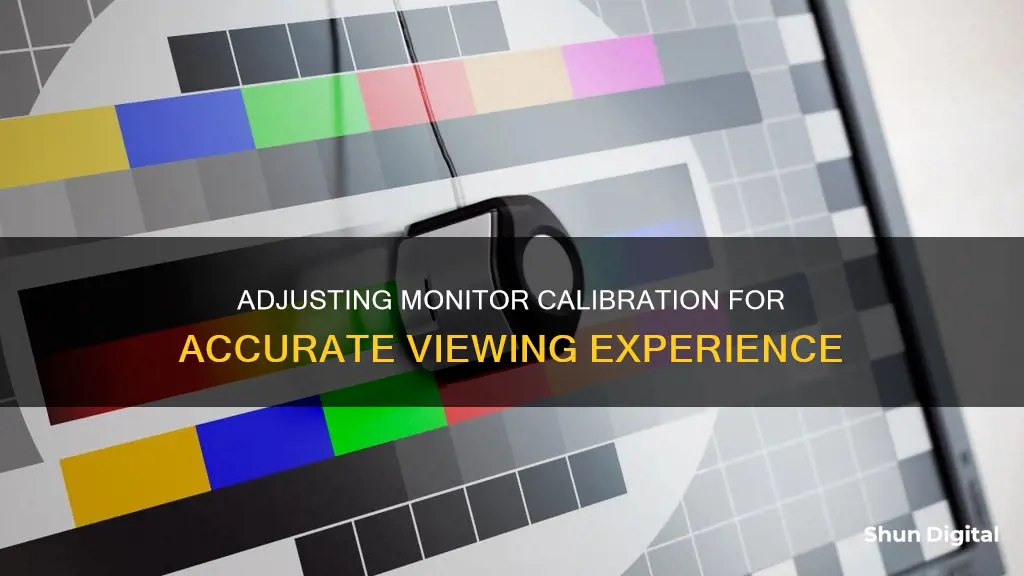
Calibrating your monitor is essential to creating the perfect listening environment. It ensures that the sound translates perfectly from one speaker to another and makes the mixing process easier. The process of calibration involves the use of sound samples, such as pink noise, and an SPL meter. Pink noise is ideal for calibration as it consists of every frequency band at the same level. The SPL meter, on the other hand, measures the change in air pressure caused by sound. By using these tools and adjusting the monitor's output level, you can achieve a standardised listening experience that suits your studio space.
| Characteristics | Values |
|---|---|
| Purpose | To create a standard volume level for reference, present an accurate representation of the frequency range, and present an accurate stereo image. |
| Benefits | Calibration helps preserve your hearing, makes the mixing process easier, and ensures the sound translates perfectly from one speaker to another. |
| Calibration methods | Subjective Calibration Standard, Empirical Calibration Standard |
| Calibration tools | Sound Pressure Level (SPL) meter, audio clip/file of pink noise, monitor controller/volume pot, digital audio workstation (DAW) |
| SPL meter specifications | C-weighted scale, slow or averaging mode |
| Pink noise specifications | Consists of every frequency band at the same level, purchased or downloaded online |
| Calibration process | Turn down independent level controls, set interface output to unity, set SPL meter specifications, play pink noise, adjust volume until SPL meter reaches the desired level, repeat for each speaker |
What You'll Learn

Calibration helps your ears get accustomed to a standard volume level
By calibrating your monitors, you can listen to sound in your environment more accurately. This is because you are listening to everything at the same SPL (Sound Pressure Level), which enables your brain to judge the levels more accurately. You will become much faster at deciding when something isn't levelled correctly, making your mixing decisions more accurate and easier.
To calibrate your monitors, you need to understand and set the level coming out of your DAW relative to the SPL leaving the speaker. This lets you know that when your mixer is set to unity, or your output level is at a marked spot, you are able to hear the volume level your speakers are calibrated to.
It's important to note that no two pieces of electronics are the same, so just setting the two volume controls to the same level isn't enough to ensure consistency between both speakers. Therefore, to calibrate, you will need to use pink noise, which consists of every frequency band at the same level. This makes it ideal for speaker and room calibration.
Rotating LCD Monitors: Any Risks Involved?
You may want to see also

Calibration helps preserve your hearing
Calibration also helps you preserve your hearing by ensuring that you are listening at a reasonable volume level. Calibrating your monitors to the required sound pressure level could result in a playback volume that is too loud. In this case, it is recommended to play back at a more reasonable level, closer to the target level, while also protecting your hearing.
Additionally, calibrating your hearing equipment is essential to ensure the accuracy of test results and provide exceptional customer care. Regular calibration, at least annually, ensures that audiometers comply with strict industry standards and the manufacturer's specific guidelines. Proper calibration can help reduce the risk of inaccurate measurements and incorrect results, which could have significant legal and financial ramifications.
Furthermore, calibration can help preserve your hearing by providing a fixed volume level for reference. When you calibrate your monitors, your ears become accustomed to that specific volume level and how it sounds in that environment. This helps you develop an intuitive sense of when your tonal balance is off or if the track is too loud or too quiet.
Studio Monitors: Vintage Hi-Fi Look, Where to Find?
You may want to see also

Calibration helps you judge levels more accurately
Calibration is a critical step in achieving a consistent and accurate listening or viewing experience. By calibrating your monitors, you're essentially standardizing the output to a known level, which has several benefits.
Firstly, calibration ensures that your ears or eyes become accustomed to a specific level. This is especially important when dealing with audio. By calibrating your monitors to a fixed volume level, your ears get used to that level in your particular environment. This helps you judge levels more accurately and makes it easier to identify when something isn't leveled correctly. For instance, in audio mixing, calibration ensures that you can accurately hear the levels of lows, mids, and highs in relation to each other, resulting in a more precise mix.
Similarly, for visual content, calibration ensures that colors are displayed correctly. Each screen displays images differently, and without calibration, you might end up with colors that appear washed out, too warm, or completely different from what others see. Calibration adjusts the colors to fit general standards, so you can trust that what you see is what others will see as well.
Additionally, calibration is essential for maintaining consistency across different devices and mediums. For audio, calibration ensures that your mix translates accurately to different speakers. In the case of visual content, calibration helps match what you see on your screen with how it looks on other devices and, most importantly, when printed. This is crucial for photographers, as it ensures that the colors, brightness, and contrast of their images remain true to their vision, regardless of the device or medium.
Finally, calibration can also help preserve your hearing. By setting a standard volume level, you reduce the risk of accidental exposure to extremely loud sounds, protecting your hearing health.
In conclusion, calibration is a powerful tool that helps standardize your equipment to a known level. It improves accuracy, consistency, and can even protect your health, making it a vital step in any creative process involving audio or visual content.
The Ultimate Guide to VESA Mounts for ASUS MX279H Monitors
You may want to see also

Calibration helps create the ultimate listening environment
Calibration is key to creating the ultimate listening environment. It ensures that your speakers deliver audio that is a true and accurate representation of the original recording. Calibration helps to create a seamless blend of frequencies, guaranteeing a well-rounded sound profile. This not only ensures a pleasurable listening experience but also allows you to hear every detail with precision.
By calibrating your speakers, you can eliminate any distortions and inconsistencies in the sound and ensure that it is delivered as the artist intended. Calibration adjusts the settings of your speakers to achieve accurate sound reproduction. It is a process of fine-tuning, ensuring that your speakers adapt to different room acoustics for the best possible performance.
The calibration process involves adjusting various parameters such as volume, timing, and frequencies. It is designed to optimise your system for the space it is in, allowing your speakers to adapt to different room acoustics. Calibration also takes into account the Fletcher-Munson curve, which states that the louder the music is, the more lows and highs are heard compared to the mids. The chosen level for calibrating is one that gives the flattest response across all frequencies.
To calibrate your speakers, you will need a Sound Pressure Level (SPL) meter and a pink noise file. The pink noise file produces an equal amount of noise across the frequency spectrum. You will play the pink noise file and adjust the monitors to match the ideal reference level for your studio. This process will help you get a more balanced frequency response, which will improve the overall sound quality of your listening environment.
How Dual Monitors Affect Disk Usage Performance
You may want to see also

Calibration helps you master your tracks like a pro
Calibration Creates a Fixed Volume Level for Reference:
When you calibrate your monitors, you set a standard volume level that your ears get accustomed to. This has two benefits. Firstly, it helps you make more accurate mixing decisions as you can easily identify when something isn't levelled correctly. Secondly, it helps preserve your hearing as you're listening to everything at the same sound pressure level (SPL).
Calibration Presents an Accurate Representation of the Frequency Range:
The Fletcher-Munson curve illustrates that our perception of frequencies changes with volume. Loud music makes lows and highs more audible compared to mids. Calibration lets you choose a level that gives a flatter response across all frequencies, ensuring a consistent and accurate representation of your music.
Calibration Assists in Accurate Stereo Imaging:
Studio monitors can vary in volume, even when set to the same position. Calibration ensures that both speakers reproduce the same level of audio, providing an accurate stereo image. This is achieved by using pink noise, which consists of every frequency band at the same level, making it ideal for speaker and room calibration.
Calibration Enhances Your Ability to Master for Different Environments:
Mastering is about ensuring your music translates well across various listening systems and environments. Calibration helps you create a uniform frequency balance and perceived loudness, so your track sounds consistent and balanced at any volume level and on different devices.
Calibration Provides a Consistent Monitoring Environment:
Monitoring at inconsistent levels can lead to poor mixing decisions. Calibration ensures a consistent monitoring environment, allowing you to make more informed choices. It also helps you maintain a dynamic range in your music, making it feel musical and exciting, rather than tight and fatiguing.
Removing BMW X5's On-Board Monitor: Step-by-Step Guide
You may want to see also
Frequently asked questions
Calibration is the process of setting the level of sound coming out of your DAW relative to the SPL leaving the speaker. This ensures that when your mixer is set to unity, or your output level is at a marked spot, you’re able to hear the volume level your speakers are calibrated to.
Calibration helps your ears become accustomed to a standard level of volume, which enables you to listen to sound in your environment more accurately. It also helps preserve your hearing. Calibration also ensures that the sound translates perfectly from one speaker to another.
You will need a Sound Pressure Level (SPL) meter, which can be a physical meter or a smartphone app, and a pink noise file.
First, turn the volume of your studio monitors all the way down. Then, set the volume of the audio interface's output level to 0dB (unity). Set the SPL meter to C-weighted and slow response. Place the SPL meter in the sweet spot of your normal listening position and play the pink noise file from your digital audio workstation with a peak of -20dB. One monitor at a time, turn up the volume until you get a reading of 75dB to 85dB on your SPL meter.







